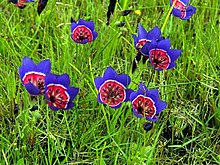
Agapanthus africanus, or the African lily, is a flowering plant from the genus Agapanthus found only on rocky sandstone slopes of the winter rainfall fynbos from the Cape Peninsula to Swellendam. It is also known as the lily-of-the-Nile in spite of only occurring in South Africa.

Satyrium coriifolium is a species of orchid endemic to the Cape Provinces. It is commonly known as the orange satyre or Ewwa-trewwa in Afrikaans.
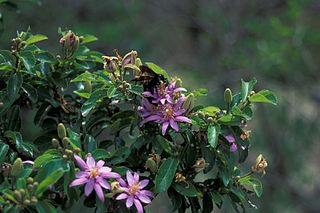
Grewia occidentalis, the crossberry, is a species of deciduous tree indigenous to Southern Africa.

Erica baccans, the berry heath, is a species of Erica that was naturally restricted to the city of Cape Town, South Africa.

Sparaxis bulbifera, commonly known as harlequin flower, is a bulb-forming perennial plant. The species is native to Cape Province in South Africa and naturalised in the Azores and Australia. It grows to between 15 and 60 cm high and has white to cream flowers. This flower is often found growing next to Geissorhiza radians. Ut has branched stems, lanceolate leaves. It is one of the few species native to sandy, waterlogged soils.
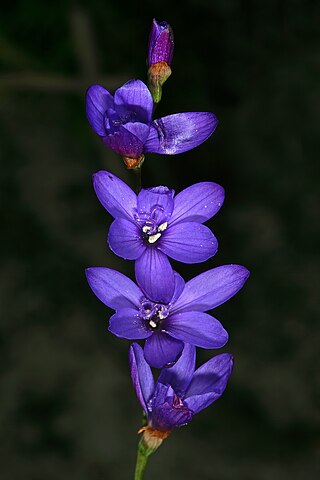
Geissorhiza aspera, also known as the blue satin flower or blou sysie, is a geophyte from South Africa.
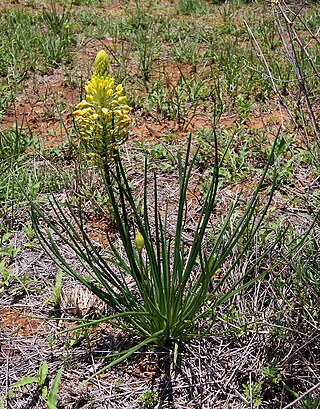
Bulbine abyssinica is a species of plant in the genus Bulbine, from eastern and southern Africa.

Drosanthemum micans, is a succulent plant in the ice plant family, Aizoaceae, indigenous to the Robertson Karoo and Overberg regions of the Western Cape Province, South Africa.

Protea aurea subsp. potbergensis, also known as the Potberg protea, or Potberg sugarbush, is a flowering plant of the genus Protea. It is endemic to South Africa and is found only in the Potberg near Cape Infanta. It grows to a height of 5 metres, and flowers primarily from May to June.
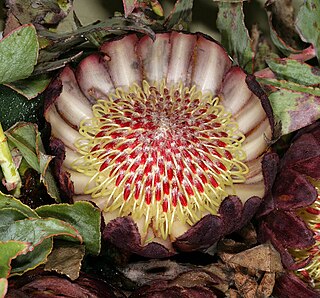
Protea amplexicaulis, the clasping-leaf sugarbush, is a flower-bearing shrub that belongs to the genus Protea. The plant is endemic to the Cape Provinces of South Africa and occurs from Citrusdal to the Kogelberg, as well as in the Langeberg. The shrub remains low and spreads out, becoming 1.3 m in diameter and flowering from June to September.

Leucadendron teretifolium, the needle-leaf conebush, is a flower-bearing shrub belonging to the genus Leucadendron and forms part of the fynbos. The plant is native to the Western Cape, South Africa.

Serruria fucifolia, the northern spiderhead, is a flower-bearing shrub that belongs to the genus Serruria and forms part of the fynbos. The plant is native to the Western Cape, South Africa.

Serruria brownii, the bottlebrush spiderhead, is a flower-bearing shrub that belongs to the family Proteaceae and forms part of the fynbos. The plant is native to the Western Cape, South Africa.
Serruria cyanoides, the Wynberg spiderhead, is a flower-bearing shrub that belongs to the genus Serruria and forms part of the fynbos.

Serruria glomerata, the cluster spiderhead, is a flower-bearing shrub that belongs to the genus Serruria and forms part of the fynbos. The plant is native to the Western Cape, it occurs on the Cape Flats and Cape Peninsula. The shrub is erect and grows only 40 cm tall and bears flowers from August to October.

Zantedeschia odorata, the Bokkeveld arum, is a species in the arum family, Araceae. It is a tuberous, perennial plant that grows to a height of 75 to 100 cm. The flowers are yellow, have long narrow veins and are enclosed by a white leathery bract. The leaves are arrow-shaped. The plant grows in wetlands or along streams. The plant is rare and indigenous to the Northern Cape where it occurs on the Bokkeveld escarpment near Nieuwoudtville.

Paranomus longicaulis, commonly known as exploding baked apple and woolly sceptre, is a flower-bearing shrub that belongs to the genus Paranomus and forms part of the fynbos. The plant is native to the Western Cape where it occurs on the eastern Langeberg from Garcia Pass to the Attakwaskloof.

Erica caffra is a small tree, sometimes a shrub, that grows in riparian habitats and on forest edges and occurs from the Western Cape to the Drakensberg of KwaZulu-Natal and Lesotho. The tree's flowers look like bells. The tree's national tree number is 572.

Leucadendron elimense, the Elim conebush, is a flower-bearing shrub, which belongs to the genus Leucadendron and forms part of the fynbos. The plant is native to the Western Cape, South Africa.

Geissorhiza splendidissima, the blue pride-of-Nieuwoudtville, is a plant species of geophyte in the family Iridaceae. It is endemic to Nieuwoudtville in the Northern Cape of South Africa. It is also called the Bokkeveld pride and splendid satin.
